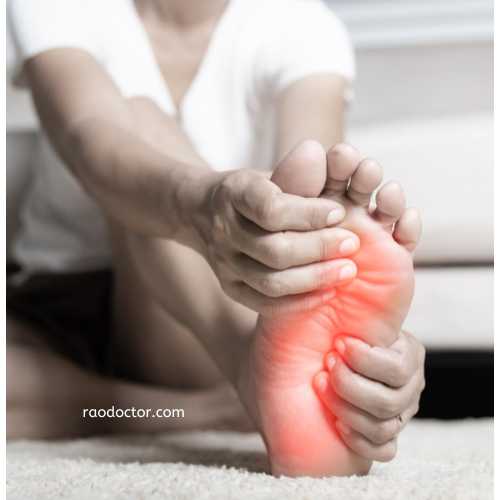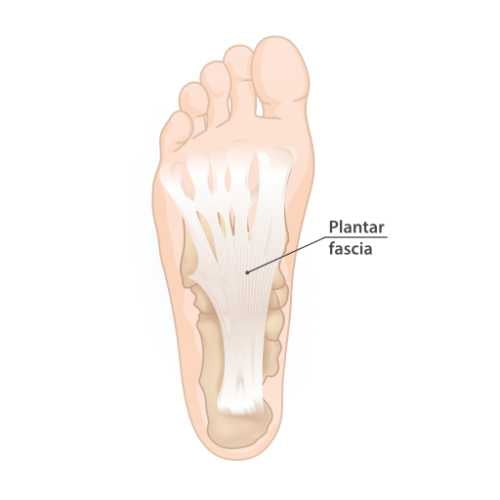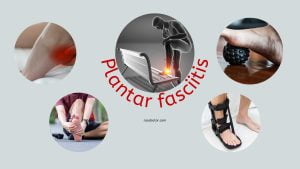Understanding Heel Pain and Plantar Fasciitis
Have you ever suffered from pain in the sole of your foot? If yes, you may be having a condition called Achilles tendinitis or plantar fasciitis.
Heel pain can be caused by a number of factors, including injuries, overuse, and certain medical conditions.

Listen to this article
When this tissue becomes inflamed, it can cause pain and discomfort in the heel and arch of your foot. Last month I published an article on one of the other foot problems- Hallux Valgus.
In line with this condition, foot pain occurs when a tissue called plantar fascia is affected by excess stretching or some injury to heel or sole of the foot.

Plantar Fascia. Image Source- Common Causes of Heel Pain and Plantar Fasciitis As mentioned earlier, plantar fasciitis is one of the most common causes of heel pain. This condition is caused by inflammation of the plantar fascia, which runs along the bottom of your foot. Other common causes of heel pain include: Achilles tendonitis: Inflammation of the Achilles tendon, which connects the calf muscle to the heel bone. Heel spurs: Bony growths that can develop on the heel bone, often as a result of plantar fasciitis. Stress fractures: Tiny cracks in the bones of the foot or ankle, often caused by overuse or repetitive stress. Tarsal tunnel syndrome: Compression of the nerves that run through the ankle, causing pain and discomfort in the heel and foot. In addition to these conditions, heel pain can also be caused by injuries such as sprains, strains, and fractures. The symptoms of heel pain can vary depending on the underlying cause. However, some common symptoms to look out for include: Pain and tenderness [pain on pressing] in the heel or arch of the foot Stiffness and limited mobility in the foot or ankle Swelling or redness in the affected area Aching or burning sensations in the foot or ankle Sharp pain when standing or walking, especially after periods of rest If you are experiencing any of these symptoms, it’s important to see a doctor or podiatrist for an accurate diagnosis and appropriate treatment plan. Fortunately, there are a number of home remedies that can help alleviate the pain and discomfort caused by heel pain and plantar fasciitis. These remedies include: Stretching is an important part of any treatment plan for heel pain and plantar fasciitis. Stretching exercises can help improve flexibility and reduce the risk of further injury. Some effective stretches for heel pain and plantar fasciitis include: One of the most common causes of heel pain is plantar fasciitis, which is a condition that affects the plantar fascia, a thick band of tissue called plantar fascia that runs along the bottom of your foot and connects the heel bone to base of your toe bones. Stand facing a wall with your hands on the wall at shoulder height. Step back with one foot and press your heel into the ground. Hold for 30 seconds and then switch sides. Sit on a chair and cross your affected foot over your opposite knee. Grasp the toes of your affected foot and gently pull them back towards your shin. Hold for 30 seconds and then release. Sit on the floor or chair with your legs extended in front of you. Use a towel or exercise band to loop around the ball of your affected foot. Gently pull the towel/exercise band towards you, stretching your toes back towards your shin. Hold for 30 seconds and then release. Whenever a patient approaches me for pain in the heel or the sole, if it is a long standing one, I tell them to get X-ray done. Most of the time, X-rays show a small growth on the calcaneum-the heel bone, called a spur [see below]. Image Source- Wikimedia Commons The pain of this condition is usually experienced the first thing after getting up in the mornings. In such a situation, I advise them to soak their heels and soles in warm water for at least 15 minutes before going to bed. This has a soothing effect and the heel or sole pain goes away after a few days. Wearing supportive footwear is essential for treating and preventing heel pain and plantar fasciitis. Look for shoes that provide ample arch support and cushioning and avoid shoes that are too tight or too loose. Some popular brands and best shoes for people with heel pain and plantar fasciitis include: Image Source-Amazon.in Image Source- Amazon.com Orthotics and shoe inserts or insoles can help support the arch of your foot and reduce the pressure on your heel. These devices come in a variety of shapes and sizes and can be custom-made or bought off the shelf. Some popular brands of orthotics and insoles plantar fasciitis include: If home remedies are not effective in treating your heel pain or plantar fasciitis, there are a number of medical treatments that may help. These treatments include: A physical therapist can help develop a customized exercise program to improve flexibility and strengthen the muscles in your feet and legs. Injections of corticosteroids can help reduce inflammation and relieve pain in the affected area. This treatment uses ultrasound shock waves to stimulate healing in the affected area. In severe cases, surgery may be necessary to repair the damaged tissue. While plantar fasciitis can be a painful and debilitating condition, the good news is that surgery is rarely necessary. In most cases, it can be effectively treated with a combination of stretching exercises, medications, and other non-invasive therapies. However, in rare cases where the pain is severe and not responding to other treatments, surgery may be recommended as a last resort. Plantar fasciitis surgery involves cutting and releasing the plantar fascia to relieve tension and pressure on the affected area. You can read all about this surgery by clicking the link to the article given below- While the procedure is generally safe, there are some potential complications to be aware of, including- As with any medical intervention, it’s important to discuss the risks and benefits of plantar fasciitis surgery with your doctor before making a decision. I usually exercise caution while advising this surgery to my patients. Prevention Tips for Heel Pain and Plantar Fasciitis Preventing heel pain and plantar fasciitis is key to avoiding the discomfort and disability that comes with these conditions. Some tips for preventing heel pain and plantar fasciitis include: Heel pain and plantar fasciitis can be debilitating conditions, but they don’t have to keep you from doing the things you love. With the right treatment plan, including stretching exercises, supportive footwear, and orthotics or inserts, you can soothe your sole and get back on your feet. If you are experiencing heel pain or plantar fasciitis, don’t hesitate to see a doctor or podiatrist for an accurate diagnosis and appropriate treatment plan. With a little patience and perseverance, you can overcome heel pain and get back to living your best life. If you have found this article useful, please consider sharing it on social media using the icons at the bottom of this article. Alternately, you can Click to Tweet below- My next article will be some knowledge on food- Plant Based Proteins as an alternative to meat for the Vegans and vegetarians.Plantar Fasciitis Symptoms
Home Remedies for Treating Heel Pain and Plantar Fasciitis
Stretching Exercises for Heel Pain and Plantar Fasciitis
Plantar fascia stretches:
Calf stretches:
Foot Stretches
Toe stretches:
My Home Remedy for Heel and Sole Pain

Shoes for Heel Pain and Plantar Fasciitis
Socks for plantar fasciitis

Orthotics and Inserts or Insoles for Heel Pain and Plantar Fasciitis

Medical Treatments for Heel Pain and Plantar Fasciitis
Physical therapy:
Steroid injections:
Shockwave therapy:
Surgery:
Surgery for plantar fasciitis
Conclusion
Final Words

